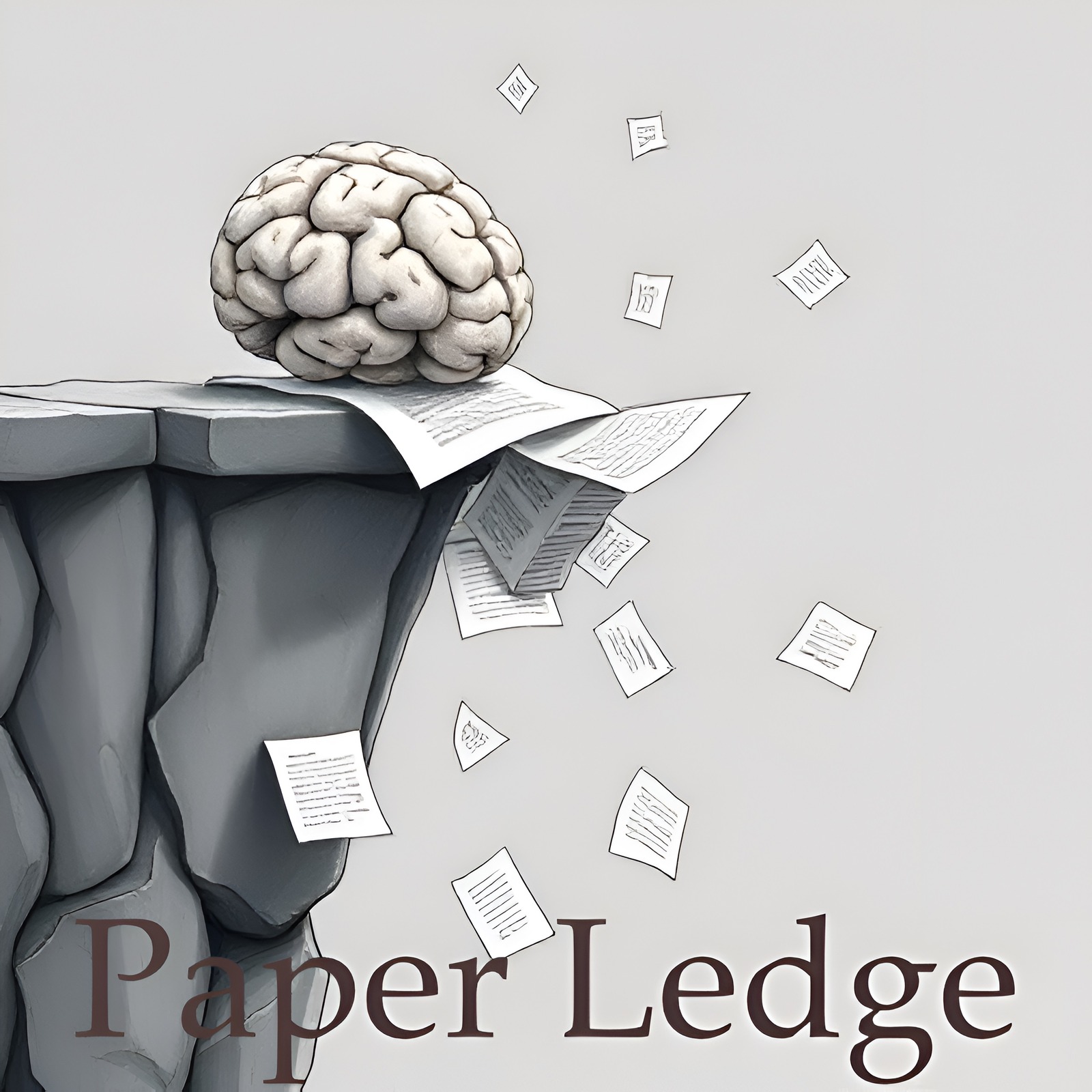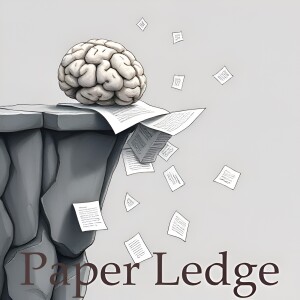PaperLedge

PaperLedge where research meets storytelling is a revolutionary podcast where cutting-edge research meets AI-powered storytelling. Hosted by the Ernis, whose blend of gentle reassurance, cosmic wonder, explanatory clarity, and enthusiastic charm makes complex research accessible to everyone. Each episode, Ernis transforms the latest academic papers into engaging, jargon-free audio experiences that deliver key insights in digestible formats. Whether you’re a researcher seeking interdisciplinary perspectives, a student supplementing your studies, or simply curious about scientific breakthroughs, PaperLedge has something for you.
Episodes
Episodes



Tuesday Oct 21, 2025
Tuesday Oct 21, 2025
Alright learning crew, Ernis here, ready to dive into some seriously cool research! Today, we're unpacking a paper that's trying to solve a HUGE problem in the world of AI: How do we get computers to understand and create things using all sorts of information – not just text, but also images, audio, and video?
Think about it. You can describe a picture in words, or you can draw a picture instead of writing words. A computer needs to be able to do both, and understand how they relate. That's where this paper comes in.
The researchers have come up with something called Latent Language Modeling (LatentLM). The core idea is to create a universal translator of sorts, a single system that can handle both discrete data, like words and code, and continuous data, like images, audio, and video. It's like teaching a computer to speak all the languages of the world, not just one!
So how does it work? Well, imagine you want to describe a photo to someone who doesn't speak your language. You might draw a quick sketch instead. LatentLM does something similar. It uses a clever technique called a Variational Autoencoder (VAE) to turn complex data like images into a simpler, more manageable form – a "latent vector." Think of it like creating a simplified blueprint of the image. This blueprint captures the essence of the image without all the messy details.
But here's the tricky part: How do you generate these blueprints in the first place? That's where something called next-token diffusion comes in. Imagine you're painting a picture one brushstroke at a time, each stroke building on the previous one. Next-token diffusion is kind of like that, but for creating these latent vectors. It starts with nothing and gradually adds information, step by step, until you have a complete blueprint.
Now, VAEs can sometimes run into a problem called variance collapse. It's like the blueprint becomes too simple and loses important details. The researchers came up with a clever fix called $\sigma$-VAE to prevent this from happening, ensuring that the blueprint captures all the important information.
Okay, so what does all this mean in the real world? The researchers tested LatentLM on a bunch of different tasks, and the results were pretty impressive:
Image Generation: LatentLM was able to create images that were just as good, if not better, than other cutting-edge AI models, and it could handle much larger images.
Multimodal Language Models: When they added LatentLM to existing language models, it made them much better at understanding and generating all sorts of data, not just text.
Text-to-Speech Synthesis: LatentLM was able to create realistic-sounding speech from text, and it did it much faster than other models. It even did a better job of capturing the speaker's unique voice.
"The results establish LatentLM as a highly effective and scalable approach to advance large multimodal models."
In essence, LatentLM is a big step towards creating AI that can truly understand and interact with the world around us in a more natural and intuitive way.
So, why should you care about all this? Well, if you're a:
Developer: This could unlock new possibilities for creating AI-powered applications that can understand and generate all sorts of data.
Artist: Imagine using AI to create new and innovative art forms that blend images, audio, and text in unexpected ways.
Educator: This could lead to new and engaging ways to teach complex concepts using multimodal learning experiences.
Anyone interested in the future of AI: This research is pushing the boundaries of what's possible and bringing us closer to a world where AI can truly understand and interact with us in a more meaningful way.
This research opens up some exciting possibilities. Here are a couple of questions that popped into my head:
Could LatentLM be used to create AI assistants that can understand our emotions and respond in a more empathetic way?
What are the ethical implications of creating AI that can generate realistic-sounding speech and images? How do we prevent it from being used for malicious purposes?
That's all for today, learning crew! I hope this gave you a good overview of LatentLM and why it matters. Until next time, keep learning and keep questioning!Credit to Paper authors: Yutao Sun, Hangbo Bao, Wenhui Wang, Zhiliang Peng, Li Dong, Shaohan Huang, Jianyong Wang, Furu Wei



Tuesday Oct 21, 2025
Tuesday Oct 21, 2025
Hey PaperLedge crew, Ernis here, ready to dive into another fascinating piece of research! Today, we're unpacking a paper about something called EmbeddingGemma. Now, that might sound super technical, but stick with me – it's actually pretty cool.
Think of EmbeddingGemma as a super-smart librarian, but instead of books, it deals with text. Its job is to understand the meaning of sentences and phrases and turn them into a sort of "digital fingerprint" called an embedding. These fingerprints allow computers to easily compare and contrast different pieces of text.
So, what makes EmbeddingGemma special? Well, the researchers built it using a clever trick. They started with a small but powerful language model called Gemma, and then they essentially taught it by having it learn from even bigger, more knowledgeable models. It's like a student learning from a panel of experts! They call this "geometric embedding distillation." Think of it like taking the concentrated essence of knowledge from those larger models.
They also added some extra ingredients to the recipe to make EmbeddingGemma even better. One cool technique they used is like giving the model a wide range of perspectives to consider, ensuring it doesn't get stuck in one particular way of thinking. They call this a "spread-out regularizer".
The amazing part? Even though EmbeddingGemma is relatively small – only 300 million parameters – it outperforms many larger models, even some of the fancy, proprietary ones! It's like a small, fuel-efficient car that can still beat a gas-guzzling monster truck in a race! The paper highlights that this model performs comparably to models twice its size. That's a huge win in terms of cost and efficiency!
Why does this matter? Well, these text embeddings are used in a ton of different applications:
Search Engines: Helping you find the most relevant results, even if you don't use the exact right keywords.
Recommendation Systems: Suggesting articles, products, or videos you might like based on what you've already enjoyed.
Spam Detection: Identifying and filtering out unwanted emails.
On-Device Applications: Because EmbeddingGemma is lightweight, it can run efficiently on your phone or other devices without needing a powerful computer in the cloud.
The researchers also found that even when they made EmbeddingGemma smaller or used less precise numbers, it still performed remarkably well. This is a big deal because it means it's even more efficient and can be used in situations where speed and resources are limited.
So, here's what I'm wondering:
Given how well EmbeddingGemma performs, could this open-source model democratize access to powerful text analysis tools, especially for smaller companies or researchers with limited resources?
The researchers used something called "geometric embedding distillation." How does that compare to other model training techniques, and what are the potential drawbacks of relying too heavily on learning from existing models? Are we in danger of simply replicating existing biases?
What kind of impact could a lightweight, high-performing embedding model like EmbeddingGemma have on the development of AI applications for low-resource languages or regions?
This research is a great example of how clever engineering and innovative training techniques can lead to powerful and efficient AI models. And the fact that it's open-source means that anyone can use it and build upon it. Really cool stuff!Credit to Paper authors: Henrique Schechter Vera, Sahil Dua, Biao Zhang, Daniel Salz, Ryan Mullins, Sindhu Raghuram Panyam, Sara Smoot, Iftekhar Naim, Joe Zou, Feiyang Chen, Daniel Cer, Alice Lisak, Min Choi, Lucas Gonzalez, Omar Sanseviero, Glenn Cameron, Ian Ballantyne, Kat Black, Kaifeng Chen, Weiyi Wang, Zhe Li, Gus Martins, Jinhyuk Lee, Mark Sherwood, Juyeong Ji, Renjie Wu, Jingxiao Zheng, Jyotinder Singh, Abheesht Sharma, Divyashree Sreepathihalli, Aashi Jain, Adham Elarabawy, AJ Co, Andreas Doumanoglou, Babak Samari, Ben Hora, Brian Potetz, Dahun Kim, Enrique Alfonseca, Fedor Moiseev, Feng Han, Frank Palma Gomez, Gustavo Hernández Ábrego, Hesen Zhang, Hui Hui, Jay Han, Karan Gill, Ke Chen, Koert Chen, Madhuri Shanbhogue, Michael Boratko, Paul Suganthan, Sai Meher Karthik Duddu, Sandeep Mariserla, Setareh Ariafar, Shanfeng Zhang, Shijie Zhang, Simon Baumgartner, Sonam Goenka, Steve Qiu, Tanmaya Dabral, Trevor Walker, Vikram Rao, Waleed Khawaja, Wenlei Zhou, Xiaoqi Ren, Ye Xia, Yichang Chen, Yi-Ting Chen, Zhe Dong, Zhongli Ding, Francesco Visin, Gaël Liu, Jiageng Zhang, Kathleen Kenealy, Michelle Casbon, Ravin Kumar, Thomas Mesnard, Zach Gleicher, Cormac Brick, Olivier Lacombe, Adam Roberts, Qin Yin, Yunhsuan Sung, Raphael Hoffmann, Tris Warkentin, Armand Joulin, Tom Duerig, Mojtaba Seyedhosseini



Tuesday Oct 21, 2025
Tuesday Oct 21, 2025
Alright learning crew, Ernis here, and welcome back to PaperLedge! Today, we're diving into a fascinating piece of research about making AI agents, the kind powered by those massive Language Models (LLMs) like GPT, a whole lot more reliable. Think of it like this: imagine a team of AI robots working together to plan your dream vacation. Sounds great, right? But what happens when something goes wrong? Who messed up the flight booking? Was it the robot in charge of finding hotels, or the one responsible for comparing prices?
That's the problem this paper tackles: Figuring out who's to blame when a multi-agent AI system goes off the rails.
See, these advanced AI systems, which the paper calls "agentic systems," are often made up of multiple smaller AI agents working together. They can use all sorts of "tools," which are like special skills or programs they can call upon. And there are complex "orchestration protocols" – think of it as the rule book that tells them how to communicate and coordinate. All this sophistication means they can do some amazing things – way better than a single, simpler AI agent could.
But here's the catch: all that complexity also makes them super fragile. It's like building a really tall Jenga tower; the more blocks you add, the easier it is for the whole thing to come crashing down.
The researchers found that even the smartest LLMs out there are surprisingly bad at figuring out why these AI systems fail. They’re only right about 10% of the time! That's like asking a world-class detective to solve a crime, and they only get it right once every ten tries. Not exactly confidence-inspiring, right?
So, what did they do about it? They created something called AgenTracer. Think of it as an AI detective specifically designed to solve these AI system failures.
First, they built a system to automatically annotate what went wrong in these AI agent interactions. They did this through a process called "counterfactual replay," which is like replaying the scenario with a slight change to see if that fixes the problem. They also used "programmed fault injection" – basically, intentionally breaking things to see what happens! This allowed them to create a TracerTraj, a curated dataset of broken AI systems.
Then, they used this data to train a smaller, more efficient AI model called AgenTracer-8B. This model is designed to be really good at spotting errors in those long, complicated interactions between AI agents. It's trained using "multi-granular reinforcement learning," a fancy way of saying it learns from both the big picture and the tiny details.
And guess what? It works really well! AgenTracer-8B beats out some of the biggest and most powerful LLMs, like Gemini-2.5-Pro and Claude-4-Sonnet, by a significant margin. It's like finding a rookie detective who's actually better at solving cases than the seasoned veterans.
“AgenTracer-8B outperforms giant proprietary LLMs like Gemini-2.5-Pro and Claude-4-Sonnet by up to 18.18%, setting a new standard in LLM agentic failure attribution.”
But here’s the really cool part: AgenTracer doesn't just point out the problem; it also helps fix it! The researchers showed that by using AgenTracer's feedback, they could improve the performance of existing multi-agent systems like MetaGPT and MaAS by a significant amount. Think of it as giving those AI robots a helpful coach who can guide them to perform better.
This research is a big deal because it paves the way for self-correcting and self-evolving AI systems. Imagine AI agents that can learn from their mistakes and improve their performance over time, without needing constant human intervention. That's the future this paper is helping to build.
Why does this matter to you?
For developers, it means building more reliable and robust AI systems.
For businesses, it means using AI to automate complex tasks with greater confidence.
And for everyone else, it means a future where AI is more trustworthy and less prone to errors.
So, here are a couple of things that popped into my head while reading this:
Given that AgenTracer-8B is smaller than the models it outperforms, what are the implications for resource efficiency and accessibility in AI development? Could this lead to more democratized access to powerful AI tools?
If AI agents can self-correct and evolve based on feedback, how do we ensure that their learning aligns with human values and ethical considerations? What safeguards need to be in place to prevent unintended consequences?
That's all for this episode of PaperLedge! I hope you found this research as fascinating as I did. Until next time, keep learning, keep questioning, and keep pushing the boundaries of what's possible!Credit to Paper authors: Guibin Zhang, Junhao Wang, Junjie Chen, Wangchunshu Zhou, Kun Wang, Shuicheng Yan



Tuesday Oct 21, 2025
Tuesday Oct 21, 2025
Hey everyone, Ernis here, and welcome back to PaperLedge! Today, we're diving into some fascinating research about how to trick AI, specifically those cool Vision-Language Models, or VLMs.
Now, VLMs are like super-smart assistants that can understand both text and images. Think of them as being able to read a book and look at the pictures at the same time to get a complete understanding. Models like GPT-4o are prime examples.
But, just like any system, they have vulnerabilities. And that's where this paper comes in. The researchers found a new way to "jailbreak" these VLMs. Now, when we say jailbreak, we don't mean physically breaking the AI, but rather finding ways to make them do things they're not supposed to – like generating harmful content or bypassing safety rules. It's like finding a loophole in the system.
The problem with existing methods for finding these loopholes is that they're often clunky and rely on very specific tricks. It's like trying to open a lock with only one key. What happens if that key doesn't work?
This research introduces something called VERA-V. Think of VERA-V as a master locksmith for VLMs. Instead of relying on one key, it tries a whole bunch of keys at the same time, learning which combinations are most likely to open the lock. It does this by creating many different text and image combinations designed to trick the AI.
"VERA-V recasts multimodal jailbreak discovery as learning a joint posterior distribution over paired text-image prompts."
Okay, that sounds complicated, right? Let's break it down. Imagine you're trying to guess someone's favorite flavor of ice cream. You wouldn't just guess one flavor, you'd think about their personality, what other foods they like, and then make a probabilistic guess, meaning you'd have a range of possibilities. VERA-V does the same thing, but with text and images, to find the most likely way to trick the VLM.
VERA-V uses three clever tricks to do this:
Typography Tricks: They subtly embed harmful cues within the text, almost like hiding a secret message in plain sight.
Image Illusions: They use AI image generators to create images with hidden "adversarial signals," basically tiny changes that are almost invisible to the human eye, but can throw off the AI. It's like showing the VLM a slightly distorted picture.
Attention Distraction: They throw in extra, irrelevant information (distractors) to confuse the AI and make it focus on the wrong things. It's like trying to find a specific word in a document that is completely filled with random and unrelated words.
So, how well does VERA-V work? The researchers tested it on some of the most advanced VLMs out there, and it consistently outperformed other methods, succeeding up to 53.75% more often than the next best approach on GPT-4o! That's a pretty significant improvement.
But why does this matter? Well, it highlights the importance of security and robustness in AI systems. As VLMs become more powerful and integrated into our lives, we need to make sure they're not easily manipulated into doing harm. Think about applications like automated medical diagnosis or autonomous driving – if someone can trick the AI, the consequences could be serious.
This research helps AI developers understand the weaknesses of their models and build better defenses. It's a crucial step in making AI systems safer and more reliable for everyone.
Here are some thoughts to ponder:
If VERA-V can find these vulnerabilities, what other, more sophisticated attacks might be possible?
How can we balance the need for powerful AI with the need for robust security and safety?
As VLMs continue to evolve, will these types of "jailbreaking" techniques become more or less effective?
That's all for today's episode of PaperLedge! I hope you found this breakdown of VERA-V insightful. Join me next time as we delve into another fascinating piece of research. Until then, stay curious!Credit to Paper authors: Qilin Liao, Anamika Lochab, Ruqi Zhang



Tuesday Oct 21, 2025
Computation and Language - REFRAG Rethinking RAG based Decoding
Tuesday Oct 21, 2025
Tuesday Oct 21, 2025
Hey PaperLedge crew, Ernis here, ready to dive into some seriously cool research! Today, we're talking about making those brainy AI models, the Large Language Models (LLMs), even faster and smarter, especially when they're doing what's called "Retrieval-Augmented Generation," or RAG.
Now, RAG is like giving your LLM a super-powered research assistant. Imagine you're asking it a question, and instead of just pulling info from its memory, it also searches the internet, grabs relevant snippets, and then uses all of that to give you the best answer possible. It's like having a super-efficient student that finds the right answers in a giant textbook.
But here's the snag: all that extra info takes time. Processing long documents slows things down, and it gobbles up memory. It's like trying to read every single page of that textbook just to answer one question – exhausting!
This research paper tackles that problem head-on. The researchers noticed something fascinating about how LLMs process information in RAG. Think of it like this: when the LLM grabs those internet snippets, it's often dealing with a bunch of different things, some relevant, some not so much. It's like a student highlighting everything in the textbook, including the table of contents and the index, instead of just the key paragraphs.
Turns out, much of that processing is unnecessary! The researchers figured out a way to make the LLM focus only on the important parts. They call their solution REFRAG, and it works in three steps:
Compress: Shrinking down the unnecessary information.
Sense: Quickly understanding what's actually important.
Expand: Focusing the effort on the need-to-know details.
Think of it like this: instead of reading the entire textbook, REFRAG helps the LLM quickly scan the table of contents, zoom in on the relevant chapters, and then focus on only the key paragraphs.
The results? Pretty amazing! They saw a 30.85% speed improvement in how quickly the LLM could give its first answer. That's a huge deal! Plus, they were able to feed the LLM even more information – making it even smarter.
Why does this matter?
For anyone using AI-powered search or chatbots: Faster responses mean a smoother, more enjoyable experience.
For businesses: More efficient AI means lower costs and better performance.
For researchers: This opens the door to building even more powerful and capable AI models.
This research shows that you can make LLMs faster and smarter by cleverly focusing on what matters. And the researchers proved their method worked across a wide range of tasks, from long conversations to summarizing lengthy documents.
So, what does this all mean for the future of LLMs and AI? Here are some thoughts to chew on:
Could REFRAG-like techniques be applied to other areas of AI, beyond just language models?
As LLMs become even more powerful, will efficiency techniques like REFRAG become essential to make them practical?
If RAG gives our AI models access to pretty much limitless knowledge, does that shift the focus from memorization to effective information processing?
That's all for this episode, learning crew! Until next time, keep those questions coming!Credit to Paper authors: Xiaoqiang Lin, Aritra Ghosh, Bryan Kian Hsiang Low, Anshumali Shrivastava, Vijai Mohan



Tuesday Oct 21, 2025
Tuesday Oct 21, 2025
Hey PaperLedge learning crew, Ernis here, ready to dive into some fascinating research! Today, we're tackling a paper that's all about medical AI, specifically those super-smart language models that are supposed to help doctors and nurses. Think of them as super-powered search engines that can also summarize patient records, suggest diagnoses, and even propose treatment plans.
Now, these AI models are acing all the tests in the lab. They're getting top marks on these standardized benchmarks. But here's the catch: just because they can ace a multiple-choice exam doesn't mean they're ready to handle real-life situations in a busy hospital. It's like giving a teenager a perfect score on their driving test and then immediately handing them the keys to an ambulance during rush hour – yikes!
This paper shines a light on this problem. The researchers argue that we need a better way to assess these medical AI models before we unleash them on patients. They propose thinking about AI autonomy in levels – kind of like self-driving cars.
Level 0: The AI is just an informational tool. Think of it as a fancy Google search for medical terms. Low risk, right?
Level 1: The AI transforms and aggregates information. It takes a bunch of data and summarizes it for the doctor. Still pretty safe, but we want to make sure it's not missing any important details.
Level 2: The AI becomes decision support. It suggests possible diagnoses or treatments, but the doctor is still in charge. This is where things get trickier – we need to be sure the AI's suggestions are accurate and unbiased.
Level 3: The AI acts as a supervised agent. It can perform tasks with minimal human oversight. This is the most autonomous level and also the riskiest. We need very strong evidence that the AI is safe and reliable before we let it do this.
The paper's point is that we should be evaluating these AI models based on what they're actually allowed to do. We need to match the right tests and metrics to each level of autonomy. We can't just rely on one overall score. It's like judging a fish by its ability to climb a tree – it just doesn't make sense.
So why does this research matter? Well, for doctors and nurses, it means having more confidence in the AI tools they're using. For patients, it means feeling safer knowing that these tools are being rigorously evaluated. And for AI developers, it provides a roadmap for building and testing these models in a responsible way.
"By centering autonomy, the survey moves the field beyond score-based claims toward credible, risk-aware evidence for real clinical use."
Essentially, the researchers are pushing for a more realistic and cautious approach to deploying medical AI. They want to move beyond simple scores and focus on building reliable, trustworthy tools that can truly improve patient care.
Here are some things I was thinking about:
If we implement this level-based evaluation, how will it impact the speed of AI adoption in healthcare? Will it slow things down, or ultimately lead to faster, safer implementation?
How do we ensure that the metrics used at each level of autonomy are constantly updated and adapted to reflect the evolving capabilities of these AI models?
This framework focuses on risk. How do we make sure we're also measuring the potential benefits of AI in healthcare, such as improved efficiency and access to care?
That's all for this episode, crew. I hope this breakdown helped make this complex topic a little more accessible. Until next time, keep learning!Credit to Paper authors: Xiao Ye, Jacob Dineen, Zhaonan Li, Zhikun Xu, Weiyu Chen, Shijie Lu, Yuxi Huang, Ming Shen, Phu Tran, Ji-Eun Irene Yum, Muhammad Ali Khan, Muhammad Umar Afzal, Irbaz Bin Riaz, Ben Zhou



Tuesday Oct 21, 2025
Tuesday Oct 21, 2025
Hey PaperLedge crew, Ernis here, ready to dive into another fascinating piece of research!
Today, we're unpacking a paper that tackles a tricky problem with those fancy Vision-Language Models, or VLMs. You know, the AI systems that can look at a picture and answer questions about it. Think of it like showing a robot a photo of a cat and asking, "What color is the cat?"
These VLMs are getting pretty good, but sometimes, even when the answer is right there in the picture, they still get it wrong. It's like they're seeing the evidence, but not believing it. Our paper wanted to figure out why this happens. Are they not actually seeing the evidence properly, or are they seeing it but just not using it effectively?
The researchers went deep, examining how these VLMs "think" layer by layer. Imagine peeling back the layers of an onion – each layer represents a different stage of processing.
What they found was really interesting: In the early layers, the VLM is mostly focused on the words of the question. But as you go deeper, the VLM starts to pay attention to specific parts of the image – the areas that contain the relevant evidence. So, it is finding the important stuff!
"VLMs often perceive the visual evidence when outputting incorrect answers, a phenomenon we term 'seeing but not believing'."
This "seeing but not believing" thing is happening a lot across many different VLM types. It’s like the VLM has all the puzzle pieces, but it's not quite putting them together correctly.
So, what can we do about it? Well, the researchers came up with a clever trick. They basically "highlighted" the important parts of the image for the VLM, forcing it to pay extra attention to the areas where the evidence was strongest. Think of it like giving the VLM a little nudge in the right direction.
And guess what? It worked! Just by highlighting the key areas, they saw a consistent improvement in accuracy across several different VLMs, including popular ones like LLaVA, Qwen, Gemma, and InternVL. The VLM already "saw" the evidence internally, but by making these signals explicit, they bridged the gap between what the VLM perceived and how it reasoned, improving performance.
This intervention is also really cool because it doesn't require any retraining of the model. It's a technique that can be implemented on models that are already deployed.
So, why does this matter?
For AI developers: This research gives us a better understanding of how VLMs work and where they're falling short. This knowledge can help us build better, more reliable AI systems in the future.
For everyday users: Imagine relying on a VLM for tasks like medical diagnosis or self-driving cars. We want to make sure these systems are accurate and trustworthy, and this research is a step in that direction.
For everyone: This research highlights the importance of understanding the limitations of AI. Just because an AI system can "see" something doesn't mean it's "understanding" it.
This study suggests that VLMs aren't always limited by their ability to see, but rather by their ability to believe what they see. It's a fascinating look into the inner workings of these complex AI systems.
Here are some questions that popped into my head:
If VLMs are "seeing but not believing," what other cognitive biases might they be exhibiting?
Could this "highlighting" technique be applied to other types of AI models beyond VLMs?
What are the ethical implications of using AI systems that can "see" but not "understand" correctly?
That's all for this episode, folks. Keep those questions coming, and until next time, keep exploring the world of AI!Credit to Paper authors: Zhining Liu, Ziyi Chen, Hui Liu, Chen Luo, Xianfeng Tang, Suhang Wang, Joy Zeng, Zhenwei Dai, Zhan Shi, Tianxin Wei, Benoit Dumoulin, Hanghang Tong



Tuesday Oct 21, 2025
Tuesday Oct 21, 2025
Alright learning crew, Ernis here, ready to dive into another fascinating paper! Today, we're tackling a topic that hits close to home for many of us: skin cancer. Now, you know early detection is key, right? But sometimes, spotting those tricky lesions can be tough, even for trained eyes.
That's where this research comes in. These scientists are working on a smart system that can automatically analyze skin images to help doctors diagnose skin cancer faster and more accurately. Think of it like this: imagine a super-powered magnifying glass with a built-in expert that can highlight exactly what to look for.
Now, the challenge is that skin lesions are incredibly diverse. Some are big and obvious, others are tiny and easily missed. And sometimes, a harmless mole can look a lot like a dangerous melanoma. So, how do you teach a computer to tell the difference?
Well, the researchers came up with a clever solution. They built a system that uses what's called a dual-encoder attention-based framework. Don't worry about the jargon! Basically, it means the system looks at the skin image in two different ways and then pays attention to the most important details.
Here's the breakdown:
First, they use a special type of AI called Deep-UNet to precisely segment the lesion. That means it draws a perfect outline around the suspicious area, like tracing a shape.
Then, they have two different AI models (DenseNet201 encoders) look at the image. One looks at the whole image, and the other zooms in on just the segmented lesion. It's like having one expert look at the big picture, and another focus on the fine details.
These two models then compare notes! They use something called multi-head cross-attention to figure out which features are the most important. It’s like a team of detectives sharing clues to solve a case!
But wait, there's more! The system also takes into account patient information, like age, sex, and where the lesion is located on the body. Think of it as adding the patient's medical history to the investigation.
So, what makes this system special? Well, it's not just about getting the right answer; it's about understanding why the system made that decision. Many AI models are like "black boxes" – they give you a result, but you don't know how they arrived at it. This can be a problem for doctors because they need to trust the system's judgment.
This new system, on the other hand, provides heatmaps that show exactly which parts of the image the AI is focusing on. It's like the AI is saying, "Hey, I'm looking at this specific spot because that's where the problem is." This helps doctors understand the system's reasoning and builds confidence in its accuracy. The researchers validated this by using Grad-CAM to ensure the system focused on the actual lesion, and not random background details!
Why does this matter? For doctors, it means having a powerful tool to help them diagnose skin cancer earlier and more accurately. For patients, it means peace of mind knowing that their diagnosis is based on solid evidence and sound reasoning. And for researchers, it means taking a big step toward building AI systems that are both accurate and trustworthy.
Here's a quote that really resonated with me:
"...integrating precise lesion segmentation and clinical data with attention-based fusion leads to a more accurate and interpretable skin cancer classification model."
So, what are some things to chew on after hearing about this?
Could this technology eventually be integrated into smartphone apps, allowing people to screen themselves for potential skin cancer risks at home? What are the ethical implications of that?
How can we ensure that these AI systems are trained on diverse datasets so they work equally well for all skin types and ethnicities?
As AI becomes more prevalent in healthcare, how do we balance the benefits of automation with the need for human expertise and empathy?
That's all for this week's paper, learning crew! I hope this sparked your curiosity and gave you a better understanding of how AI is being used to tackle real-world problems. Until next time, keep learning!Credit to Paper authors: Md. Enamul Atiq, Shaikh Anowarul Fattah







